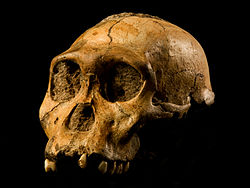Australopithecine
| Australopithecines Temporal range: Pliocene–5.6–1.2 Ma |
|
|---|---|
 |
|
| Australopithecus sediba | |
| Scientific classification | |
| Kingdom: | Animalia |
| Phylum: | Chordata |
| Class: | Mammalia |
| Order: | Primates |
| Suborder: | Haplorhini |
| Family: | Hominidae |
| Tribe: | Hominini |
| Subtribe: |
Australopithecina Gregory & Hellman, 1939 |
| Type species | |
|
†Australopithecus africanus Dart, 1925 |
|
| Genera | |
|
|
Australopithecines are generally all species in the related Australopithecus and Paranthropus genera, and it typically includes Kenyanthropus,Ardipithecus, and Praeanthropus. All these related species are now sometimes collectively classified as a subtribe of the Hominini tribe called Australopithecina. They are the extinct, close relatives of humans and, with the extant genus Homo, comprise the human clade. Members of the human clade, i.e. the Hominini after the split from the chimpanzees, are now called homonina (see Hominidae; terms "hominids" and hominins).
The terms australopithecine, et al., come from a former classification as members of a distinct subfamily, the Australopithecinae. Members of Australopithecus are sometimes referred to as the gracile australopithecines, while Paranthropus are called the "robust australopithecines".
The australopithecines occurred in the era and were bipedal, and they were dentally similar to humans, but with a brain size not much larger than that of modern apes, with lesser encephalization than in the genus Homo. Humans (genus Homo) may have descended from australopithecine ancestors and the genus Ardipithecus is a possible ancestor of the australopithecines.
Phylogeny of subtribe Australopithecina according to Briggs & Crowther 2008, p. 124.
The post-cranial remains of australopithecines show they were adapted to bipedal locomotion, but did not walk identically to humans. They have a high brachial index (forearm/upper arm ratio) when compared to other hominins, and they exhibit greater sexual dimorphism than members of Homo or Pan but less so than Gorilla or Pongo. It is thought that they averaged heights of 1.2–1.5 metres (3.9–4.9 ft) and weighed between 30 and 55 kilograms (66 and 121 lb). The brain size may have been 350 cc to 600 cc. The postcanines (the teeth behind the canines) were relatively large, and had more enamel compared to contemporary apes and humans, whereas the incisors and canines were relatively small, and there was little difference between the males' and females' canines compared to modern apes.
...
Wikipedia
